Boggs S. Principles of Sedimentology and Stratigraphy
Подождите немного. Документ загружается.

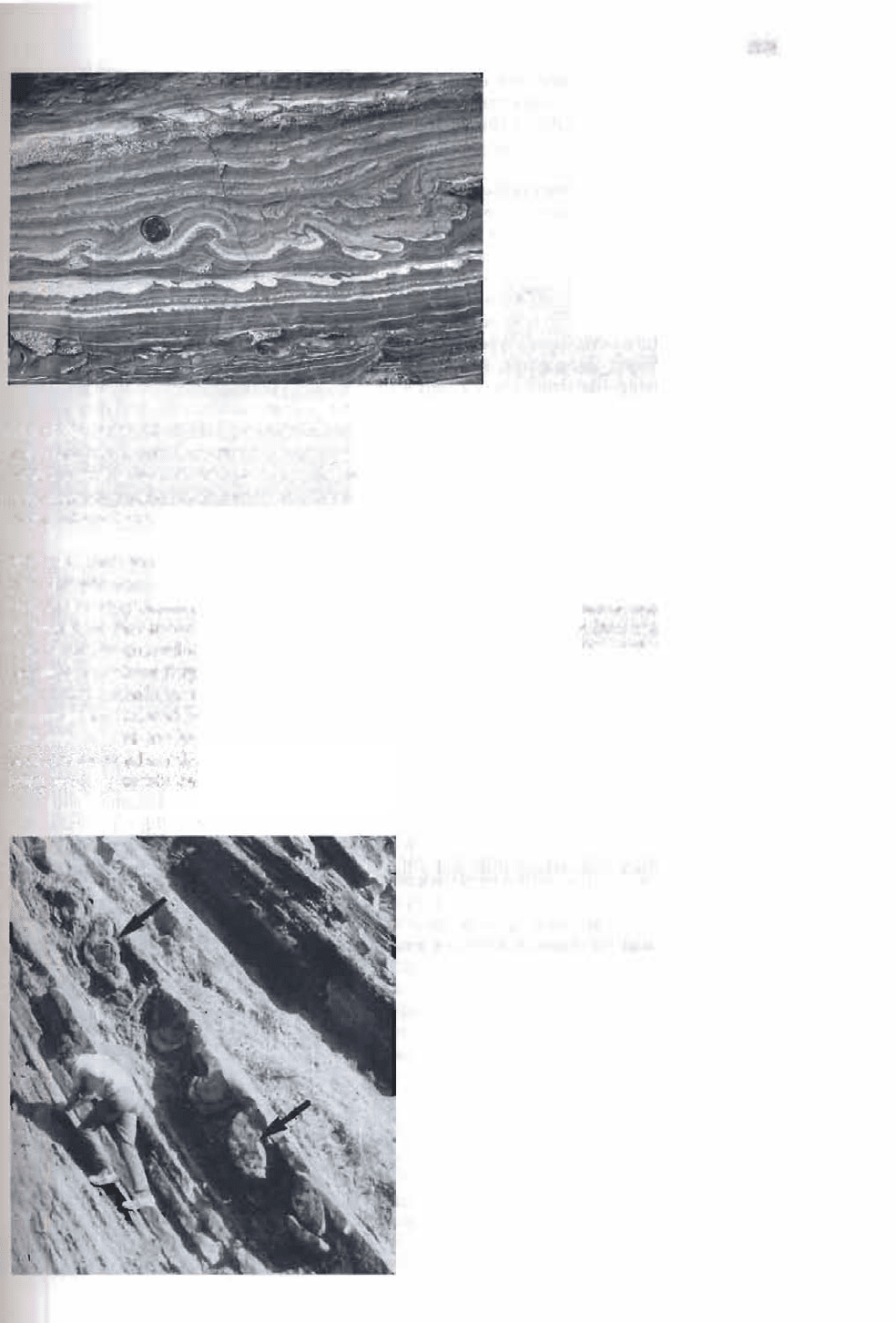
4.3 Stratification and Bedforms
95
Figure 4.27
Flame structures in a thin-bedded, fine sandstone
shale succession, Elkton Siltstone, southwestern
Oregon. The best developed flames are in the layer
immediately below the coin.
caused by sediment loading. They are probably caused mainly by loading of
water-saturated mud layers which are less dense than overlying sands and are
consequently squeezed upward into the sand layers. The orientation of over
tued crests suggests that loading may be accompanied by some horizontal drag
or movement between the mud and sand bed.
Ball and Pillow Structures. Ball and pillow structures are present in the lower
part of sandstone beds, and less commonly in limestone beds, that overlie shales
(fig. 4.28). They consist of hemispherical or kidney-shaped masses of sandstone
or
limestone that show internal laminations. some hemispheres, the laminae
may be gently curved or deformed, particularly next to the outside edge of the
hemispheres where they tend to conform to the shape of the edge. The balls and
pillows may remain connected to the overlying bed, as Figure 4.28, or they may
be completely isolated from the bed and enclosed in the underlying mud. Ball and
p
iow structures are believed to form as a result of foundering and breakup of
semiconsolidated sand, or limy sediment, owing to partial liquefaction of under
lying mud, possibly caused by shocking. Liquefaction of the mud causes the
Figure 4.28
Ball and pillow structures (arrows) on the base of a thin,
steeply dipping sandstone bed. Lookingglass Formation
(Eocene), near lllahe, southwestern Oregon.

96
C11apter 4 I Sedimenta Structures
Figure 4.29
overlying sand beds or limy sediment to deform into hemispherical masses that
may subsequently break apart from the bed and sink into the mud. Kuenen (1958)
e
xperimentally produced
structmes that closely resemble natural ball and pillow
structures by applying a shock to a layer of sand deposited over thixotropic clay.
Synsedimentary Folds and Faults. The general term slump structures has been ap
plied to structures produced
by penecontemporaneous deformation resulting
from movement and displacement of unconsolidated or semiconsolidated sedi
ment, mainly under the inuence of gravity. Potter and Pettijolu1 (1977) describe
slump structures as being the products of either (1) pervasive movement involv
ing the interior of the transported mass, producing a chaotic mixture of dferent
types of sediments, such as broken mud layers embedded in sandy sediment, or
(2) a decollement type of movement in which the lateral displacement is concen
trated along a sole, thus producing beds that are tightly folded and piled into
nappelike structures (e.g., Fig. 4.29).
Slump structures may involve many sedimentation wuts, and they are com
monly faulted. Thicknesses of slump units have been reported to range from less
than 1 m to more than SO m. Slump units may be bounded above and below by
strata that show no evidence of deformation. It may be difficult in some strati
graphic successions, hO\'I'ever, to differentiate between slump units and incompe
tent beds such as shale that were deformed between competent sandstone or
limestone beds during tectonic folding .
Slump structures typically occur mudstones and sandy shales and less
commonly in sandstones, limestones, and evaporites. They are generally found in
w1its that were deposited rapidly, and they have been reported from a variety of
en
vironments where rapid sedimentation and oversteepened slopes lead to insta
bility. They occur glacial sediments, varved silts and clays of lacustrine origin,
eolian dune sands, turbidites, delta and reef-front sediments, subaqueous dune
sediments, and in sediments from the heads of submarine canyons, continental
shelves, and the walls of deep-sea trenches.
Dish and Pillar Structures. Dish structures are thin, dark-colored, subhorizontal,
flat to concave-upward, clayey laminations (Fig. 4.30) that occur principally
sandstone
and siltstone units (Lovve and LoPiccolo, 1974; Rautman and Do�,
1977). The laminations are commonly only a few millimeters thick, but individual
dishes may range from 1 em to more than 50 em wide. They typically occur
thick beds where dish and pillar structures may be the only structures visible.
Small-scale decollement-type synsedimentary folds (arrows) in
thin, fine-grained sandstone layers interbedded with shale, Elk-
ton Siltstone (Eocene), southwestern Oregon.
·
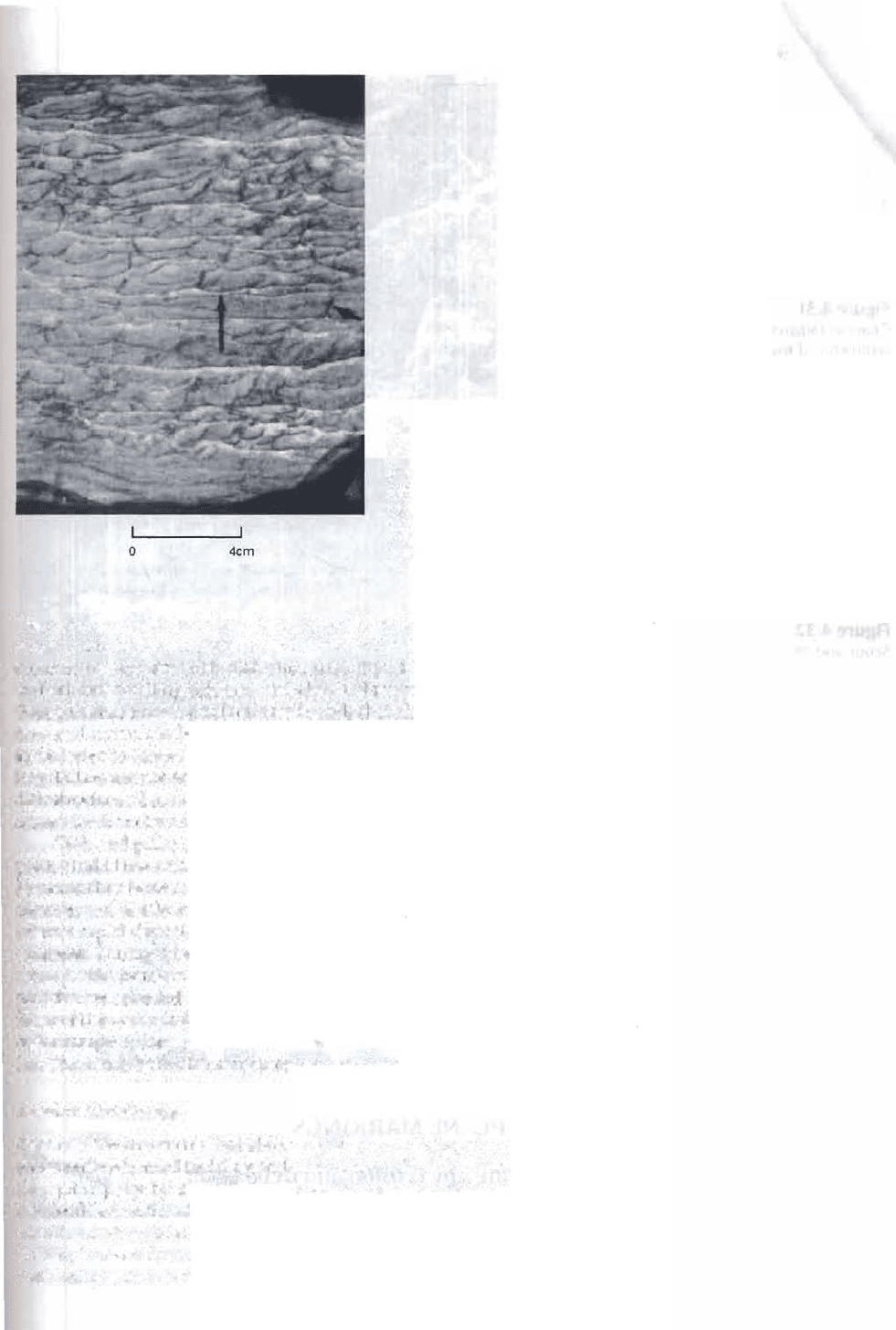
Figure 4.30
4.3 Stratification and Bedforms 97
Strongly curved to nearly flat dish structures (large arrow) and pillars
(small arrows) formed by dewatering of siliciclastic sediment, jack
fork Group (Pennsylvanian), southeast Oklahoma. [From lowe, D. R.,
1975, Water escape structures in coarse-grained sediment: Sedimen
tology, v. 22, Fig. 8, p. 175, reprinted by permission of Elsevier Sci
ence Publishers, Amsterdam.]
They also occur in beds less than about 0.5 m thick, where they commonly cut
ac ross primary flat laminations and other laminations. Pillar structures generally
c ur in association wth dish structures (Fig. 4.30). Pillars are vertical to near
vertical, cross-cutting cols and sheets of structureless or swirled sand that cut
thugh either massive or laminated sands that also commonly contain dish struc
tus and convolute laminations. They range in size from tubes a few millimeters
in diameter to large struch1res greater than 1 m in diameter and several meters
long. Pillars are not actually stratification structures. They are discussed here with
dish structures because of their close association with these structures and be
cause they form by a similar mechanism, discussed below.
Dish and pillar structures were first observed in sediment gravity-flow de
posits (turbidites and liquefied flows) and are most abundant in such deposits;
however, they have now also been reported in sediments from deltaic, alluvial, la
custrine, and shallow marine deposits, as well as from volcanic ash layers. They
indicate rapid depostion and form by escape of water during consolidation of
siment Dming gradual compaction and dewatering, semipermeable laminae
act as partial barriers to upward-moving water carrying fine sediment. The fine
particles are retarded by the laminae and are added to them, forming the dishes.
me of the water is forced horizontally beneath the laminations until it finds an
sier esape route upward. This forceful upward escape of water forms the pil
lars.llherefore, both dish structures and pillars are dewatering structures.
Erosion Structures
Channels are structure that show a U-shape or V-shape in cross section and cut
acrs earlier-formed bedding and lamination (Fig. 4.31). They are formed by ero
sion, principally by urrents but in some cases by mass movements. Channels
may be filled with sediment that is texturally different from the beds they trun
ca. Channels visible in outcrop range in width and depth from a few centimeters
to many meters. Even larger channels may be definable by mapping or drilling. It
seldom possible to trace their length in outcrop, but they can presumably extend
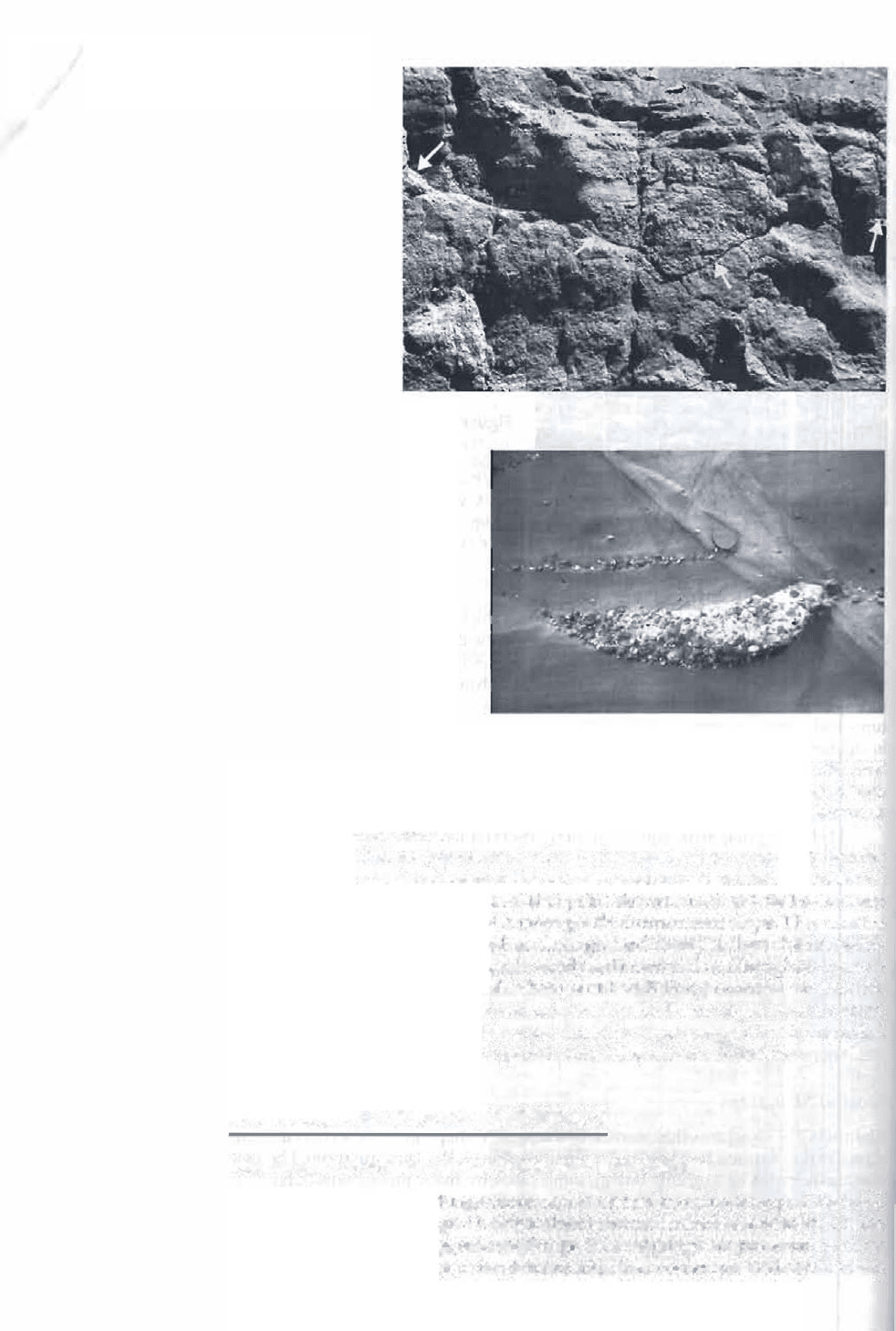
98 Chapter 4 I Sedimentary Structures
Figure 4.31
Channel (arrows) incised into fluvial, volcaniclastic
sediments of the Colestin Formation (Eocene),
Oregon-California border. Width of the channel is
-4 -Sm.
Figure 4.32
Scour-and-fill structures in Miocene sandstone, Blacklock Point,
southern Oregon coast. A small depression was scoured into
underlying sand by currents, then filled with gravel and sand.
Lens cap for scale.
for distances many times their width. Channels are very common fluvial and
tidal sediments. They also occur in turbidite sediments, where the long dimen
sions of the channels tend to be oriented parallel to current direction as shown by
other directional structures.
Scour-and-fill structures are similar to channels but are commonly smaller
(Fig. 4.32). They consist of smalL filled asymmetrical troughs a few centimeters to
a few meters in size, with long axes hat point downcurrent and that commonly
have a steep upcurrent slope and a more gentle downcurrent slope. They may
filled with either coarser grained or finer grained material than the substrate.
These structures are most common in sandy sediment and are thought to form as
a
result of scour by currents and subsequent backfilling as current velocity de
creases. contrast to channels, several scoUI-and-fill structures may occur to
gether closely spaced in a row. They are primarily structures of fluvial origin that
can occur river, alluvial-fan, or glacial outwash-plain environments.
4.4 BEDDING-PLANE MARKINGS
Markings Generated by Erosion and Deposition
Many bedding-plane markings o'cr on the underside of beds as positive-relief
casts and irregular markings. Owing to their location on the bases or sotes of beds,
they are often referred to ?S sole markings. Sole markings are preserved particu
larly well on the undersides of sandstones and other coarse grained sedimentary
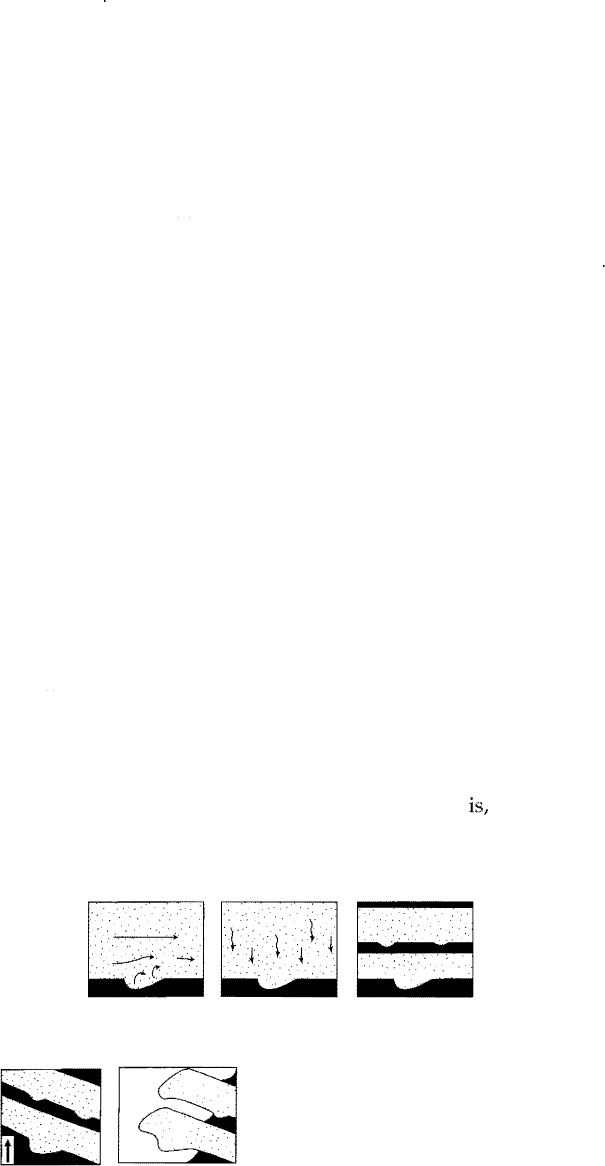
4.4 Bedding-Plane Markings
99
cks that overlie shale beds. Many sole markings show directional features that
make them very useful for inteting e ow directions of ancient currents.
These so-called erosional sole markings are actually formed by a two-stage
pcess that involves both erosion and deposition. First, a cohesive, fine-sediment
bottom is eroded by some mechanism to produce grooves or depressions. Because
of
e cohesiveness of the sediment, the depressions may be preserved long
enough to be filled in and buried during subsequent deposition, typically by
coarser-grained sediment than the bottom mud. This coarser sediment is probably
deposited very shortly after erosion produced the depression, possibly in some
cases by the same current that formed the depression. After burial and lithifica
on, a positive relief feature is left attached to the base of the overlying bed. If the
bed subsequently undergoes tectonic uplift, these structures may be exposed by
weaering and subaerial erosion (Fig. 4.33). The initial erosional event that cre
ates the depressions in a mud bottom can take e form of current scour, or the de
pression can result from the action of objects called tools at are carried by the
cuent and intermittently or continuously make contact with the bottom. These
tools can be pieces of wood, the shells of organisms, or any similar object that can
be rolled or dragged along the bottom. Erosional structures may thus be classified
genetically as either current-formed structures or tool-formed structures.
Erosional sole markings are most common on the soles of turbidite sand
stones, but they are also present in sedimentary rocks deposited in other environ
ments. They can form in any environments where the requite conditions of an
erosive event followed reasonably quickly by a depositional event are met. They
have been reported in both fluvial and shelf deposits in addition to turbidites.
Groove Casts
Groove casts are elongate, nearly straight ridges that result from infilling of ero
sional relief produced as a result of a pebble, shell, piece of wood, or oer object
ing dragged or rolled across the surface of cohesive sediment (Fig. 4.34). They
ically range in width from a few millimeters to tens of centimeters and have a
lief of a few millimeters to a centimeter or two; however, much larger groove
casts also occur. Groove casts are greatly elongated in comparison to their width.
They are directional features that are oriented parallel to the flow direction of the
ancient currents that produced them; thus, they have paleocurrent significance.
Groove casts on the same bed commonly have the same general orientation, al
ough they may diverge at slight angles and even cross. Most groove casts do not
have features that show the unique flow diction; that we cannot tell from them
which direction was down current and which upcurrent. Chevrons are a variety of
Tectonic
tilting
Erosion of bed
�
.
r
l
�
·
·•
·
··•
·
>
.
·•
·
··.
·
•
·
.
.
.
t
Lt.·
·
... · ..
.
.
.
.
<
.
·
.
·
·
.
·
·
.
..
·. .
.
.
.
.
.
·
.'
.
.
.
·
. .
.
.
.
.
·
Deposition
Burial and
lithification
�
·
.
.
·
.
·
.
·
.
·
.
.
.
·
.
.
·
.
·
·
·
·
·
·
·
·
·
·
·
·
·
·
·
·
·
·
.
·
·
.
·
�
·
.
.
.
..
.
.
·
·
.
.
.
.
.
.
.
.
.
.
· ..•...
.
·
.
·.
·
·
·
···
·
·
·
·
·
·
•
.
...
.
.
•..
.
•
.
.
.
• .
.
·
.
·
·
.
.
·.
·
.··
·
·
.
.
••.•
.
•
.
...
·
·
.
.
.
.
...
.
.
.
.
.
··
·
·
.
.
.
·.
Subaerial
erosion
Tectonic
overturning
Subaerial
erosion
Figure 4.33
Postulated stages of development of sole
markings owing to erosion of a mud bottom
followed by deposition of coarser sediment.
The diagram also illustrates how the sole
markings appear as positive-relief features on
the base of the infilling bed after tectonic up
lift and subaerial weathering; it suggests how
sole markings can be used to tell top and
bottom of overturned beds. [From Collinson,
J. D., and D. B. Thompson, 1982, Sedimenta
structures, Fig. 4.1, p. 37, reprinted by
permission of George Allen & Unwin, Lon
don. Aer Ricci Lucchi, , 1970, Sedimen
tografia: Zanchelli, Bologna, Italy.]
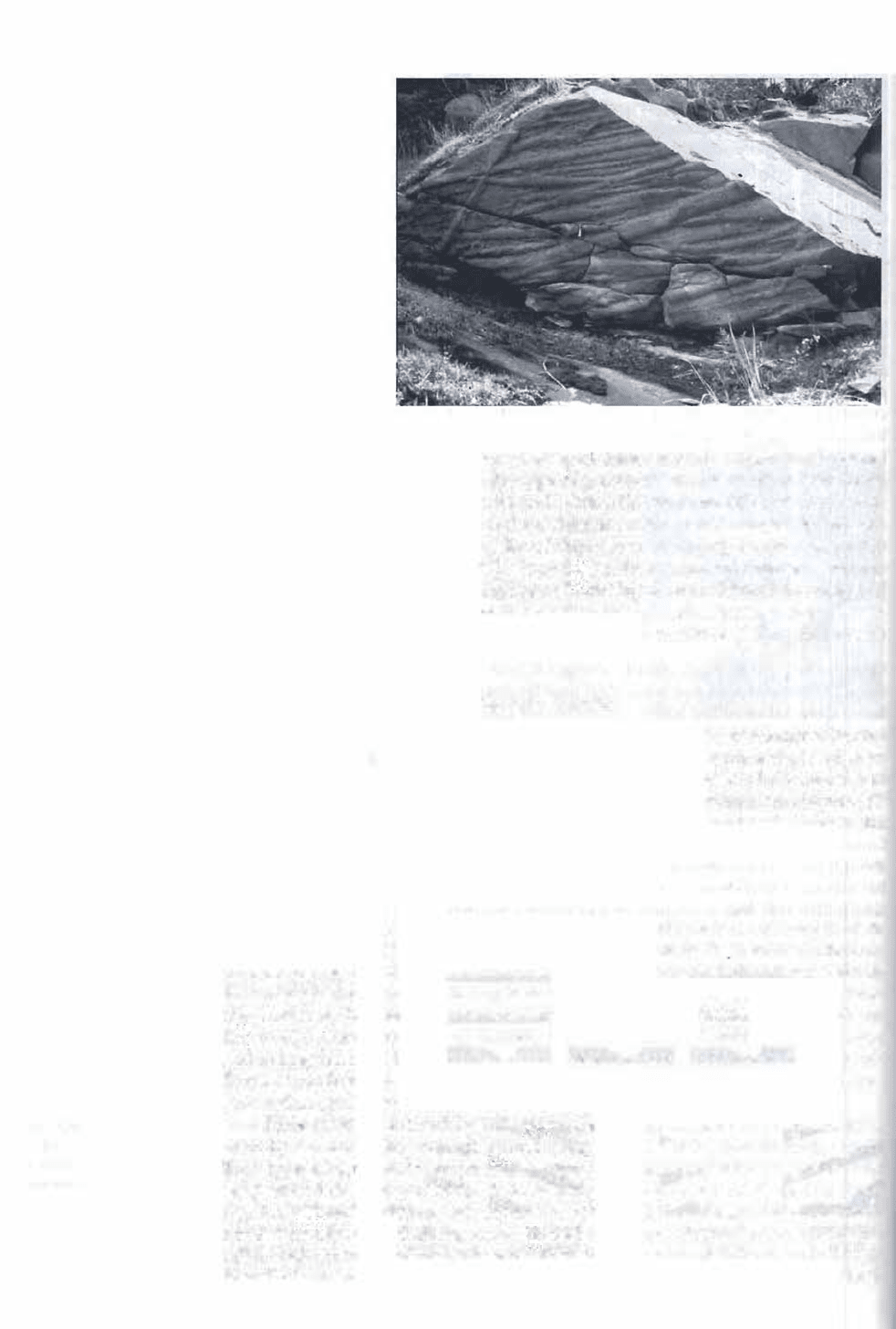
1 00 Chapter 4 I Sedimentary Structures
Figure4.34
Large intersecting groove casts on th e base of a
turbidite sandstone bed, Fluornoy Formation
(Eocene), Oregon Coast Range.
groove casts made up of continuous V-shaped crenulations in which the V points
in a downstream direction; thus, this type of groove cast can be used to determine
the true direction of flow. Dzulyrtski and Walon (1965) suggest that chevrons are
formed by tools moving just above the sedimeul surface but not touching the sur
face, causing rucking-up of the ides of e groove. Groove casts are especially
common on the soles of turbidite beds owing to shell fragments, pieces of wood,
or other tools that are carried in th� base of turbidity current flows being dragged
across a mud bottom. They occur also on the soles of beds deposited in shallow
water environments such as tidal flats and flood plains where floating tools may
touch bottom and leave grooves.
Bounce, Brush, Prod, Roll, and Skip Marks
Small gouge marks are produced by tools that make intermittent contact with the
bottom, creating small marks. Brush and prod marks are asymmetrical in cross
sectional shape, and the deeper, broad part of the mark is orieflted downcurrent.
Bounce marks are roughly symmetrical. Roll and skip marks are formed hy a tool
bouncing up and down or rolling over the surface to produce a continuous track.
The genesis of these structures is illustrated in Figure 4.35.
Flute Casts
Flute casts are elongated welts or ridges that have a bulbous nose at one end that
flares out in the other direction and merges gradually with the surface of the bed
(Fig. 4.36). They occur singly or in swarms in which all of the flutes are oriented in
the same general direction. On a given sole, the flutes tend to be about the same
s�ze; however, ute casts on different beds can range in width hom a centimeter or
two to 20 em or more, in height (relief) from a few centimeters to 10 em or more,
and in length from a few centimeters to a meter or more. The plan-view shape of
flutes varies from nearly streamline, bilaterally symmetrical forms to more elon
gate and irregular forms, some of which are highly twisted.
flute casts are formed by filling
.
of a depression scoured cohesive sedi
ment by current eddes created behind some obstacle, or by chance eddy scour.
This type of curren scour produces asymmetrical depressions in which the
steepest and deepest part of the depression is oriented upstream or upslope (see
Fig. 4.33). Therefore, when such depressions are filled, the filling forms a positive
relief struetUJe with a bulbous nose oriented upstream. Flute casts thus make ex
ceUent paleocurrent 1dicators because they show the unique direction of current
flow. Flutes are particularly prevalent on the soles of turbidite sequences, but they
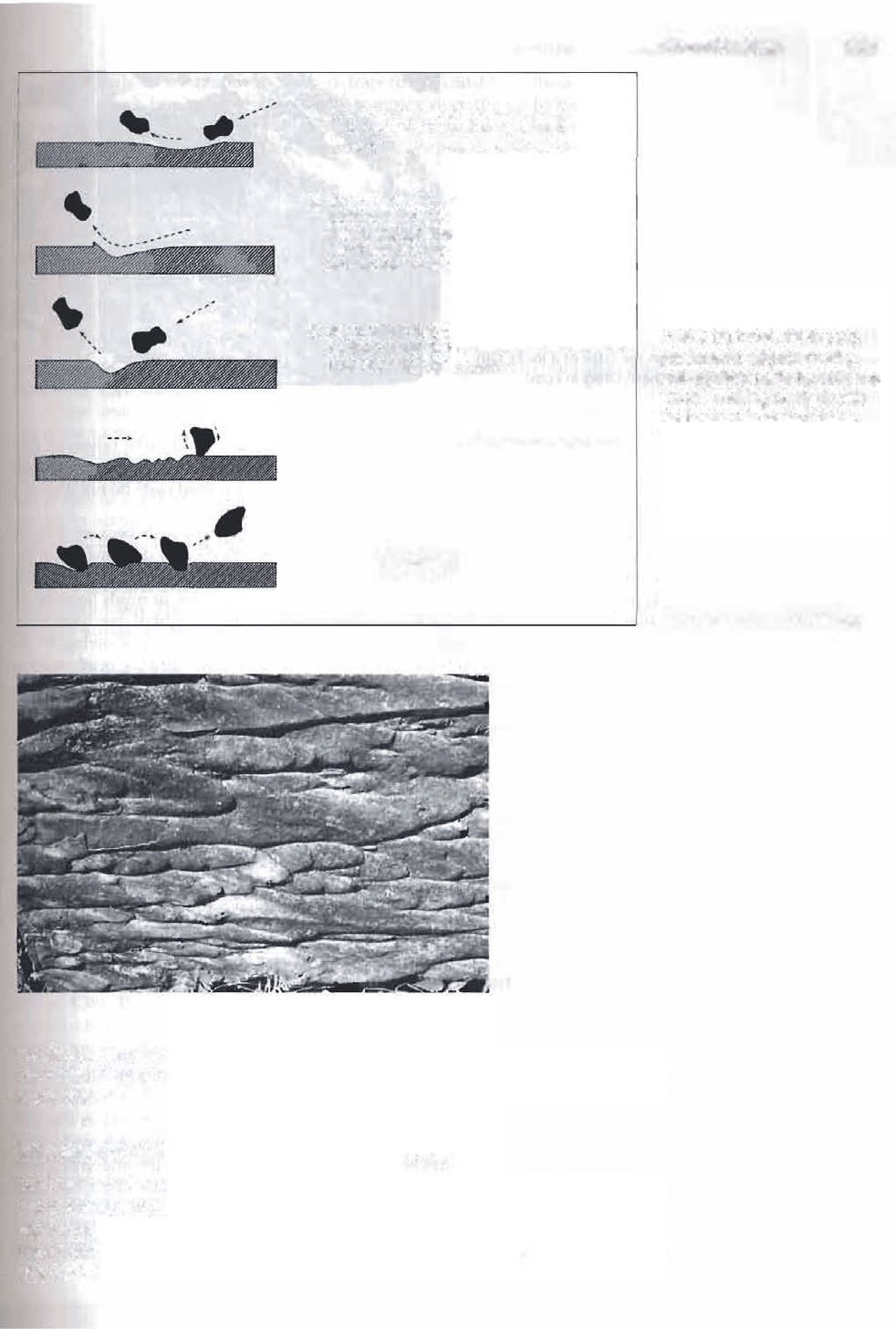
4.4 Bedding-Plane Markings
101
A
Bounce marks. The tool approaches the
sediment suace at a lo
w
angle and
immediately bounces back into the current.
B Brush marks. The tool approaches the
sediment surface at a very lo
w
angle,
w
ith the
axis ol the tool inclined upcurrent, and is then
lifted a
w
ay by the current, producing a ridge
of mud do
w
ncurrent of the mark.
C Pr marks. The tool reaches the sediment
suace at a fairl ligh angle and is then lifted
up and a
w
ay by the current.
D Roll marks. The tool rolls over the sediment
suace, producing a continuous roll mark.
E Skip marks. The tool travels do
w
ncurrent
w
ith
a sal tating movement, hitting the se diment
surface at nearly regular intervals.
Figure 4.36
Figure 4.35
Development in a cohesive
mud bottom of (A) bounce
marks, (B} bru marks, (C)
pr marks, (D) mil marks,
and (E) skip marks by action of
" tools" making contact with
the bott in various ways.
These tool-formed depressions
are subsequently filled with
coarser sediment to produce
positive-relief casts. [After Rei
neck, H. E., and I. B. Singh,
1 980, Depositional sedimenta
ry environments, 2nd ed., Fig.
127, 129, 125, 132,
p. 82, 83,
reprinted by permission of
Springer-Verlag, Heidelberg.]
Flute casts on the base of a turbidite sandstone,
Fluornoy Formation (Eocene), Oregon Coast
Range. The bulbuous terminations of the flute
casts indicate that paleocurrent flow was from right
to left. [Photograph courtesy of Ewart Baldwin.]
a also present in sediments deposited in shallow marine and nomnarine envi
nmen
ts. They have been reported on
the soles of limestone beds as well as sand
stone beds.
Markings
Generated by Deformation: Load Casts
ad c a described by Potter and Pettijohn (1977) as "swellings ranging from
slight
bulges, deep or shallow rounded sacks, knobby excrescences, or highly ir
gular protuberance." They commonly occur on the soles of sandstone beds that
overlie mudstones or shales, and they tend to cover the entire bedding surface
(g. 4.37). They range in diameter and relief from a few centimeters to a few tens
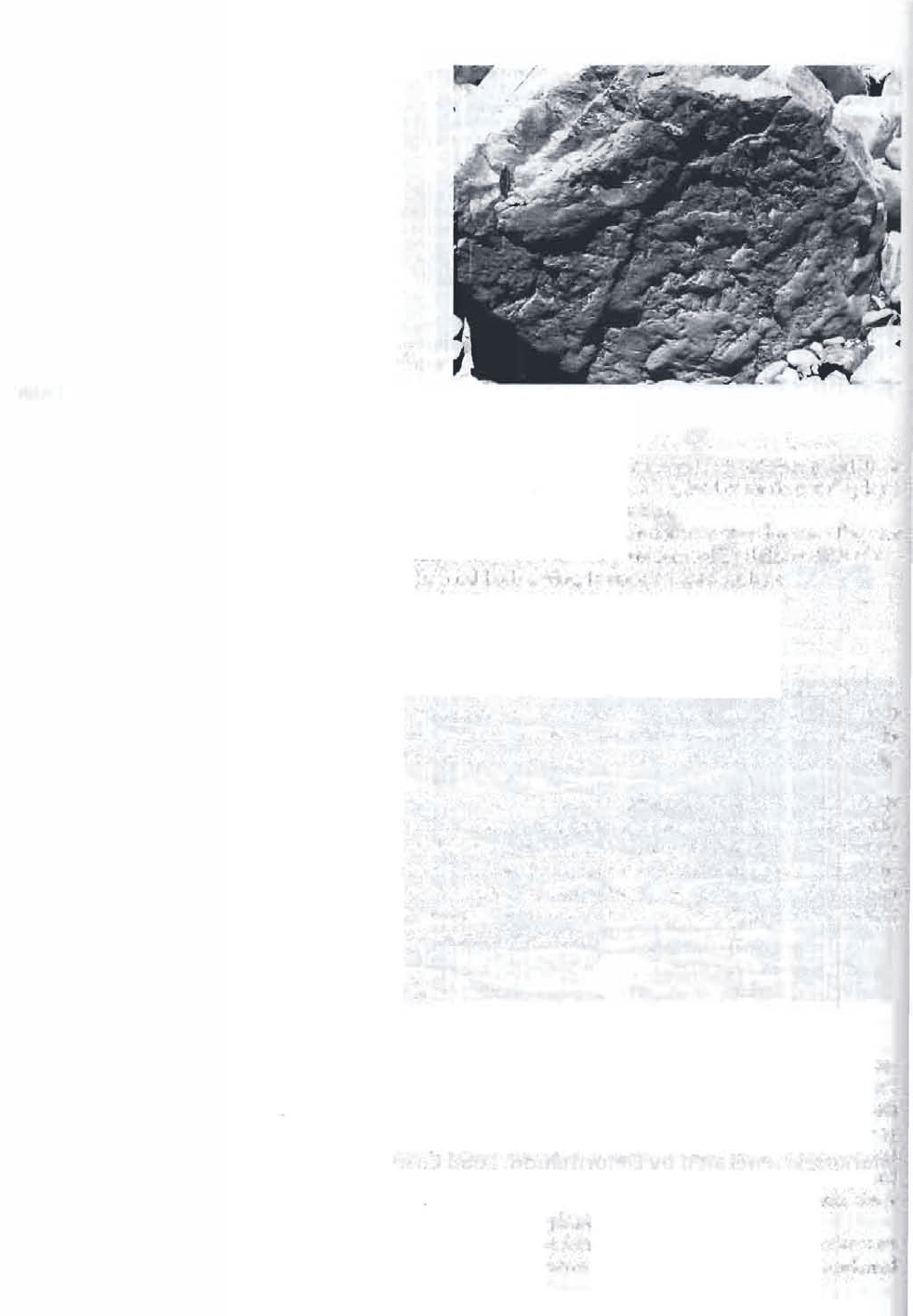
1 02
Chapter 4 I Sedimentary Structures
Figure 4.37
Irregularly shaped load casts on the base of a loose slab
of Cretaceous sandstone, southern Oregon coast.
of centimeters. Load casts may superficially resemble flute casts; however, they
can be distinguished from flutes by their greater irregularity f shape and their
lack of definite upcurrent and downcurrent ends. Also, load casts do not dispfay a
preferred orientation with respect to current direction.
Although they are called casts, load casts are not true casts because they are
not fillings of a preexisting cavity or mold. They are formed by deformation of un
compacted, hydroplastic mud eds owing to unequal loading by overlying sand
layers. Uncompacted muds with excess fluid pore pressures, or muds liquefied by
an externally generated shock, can be deformed by the weight of overlying sand,
which may sink unequally into the incompetent mud. Loading owing to un
equal weight of the sand forces protrusions of sand down into the mud, creating
positive-relief features on the base of the sandstone beds that may resemble some
erosional structures, as mentioned. Load casts are closely related genetically to
ball and pillow structures and flame structures. Flute and groove casts may
modified by loading, wch tends to exaggerate their relief and destroy their orig
inal shapes.
Load casts can form in any environment where water-saturated muds are
quickly
buried by sand before
dewatering can take place. They do not indicate an}'
particular environment, although they tend to be most common in turbidite
quences. Their presence on the bases of some beds and not on others seems to re
flect the hydroplastic state of the nnderlying mud. They apparently will not form
on the bases of sand beds deposited on muds that have already been compacted or
de,atered prior to deposition of the sand.
Biogenic Structures
T ce Fossils
The burrowing, boring, feeding, and locomotion activities of organisms can pro
duce a variety of trails, depressions, and open burrows and borings in mud or senti
consolidated sediment bottoms. Filling of these depressions and burrows with
sediment of a different type or with different packing creates structures that may
be either positive-relief features, such as trails on the bases of overlying
beds, or
features that shmv up as burrow or bore fillings on the tops of the underlying mud
bed. Bu rrows and borings commonly extend down into beds; therefore, the
structures are not exclusively bedding-plane structures.
Tr acks, trails, burrows, borings, and other structures made by organisms on
bedding surfaces or within beds known collectively as trace fossils, also referred

4.4 Bedding-Plane Markings
103
as ichnofosss, or lebensspuren. Study of trace fossils constitutes the discipline of
ichnology, which has become increasingly complex since the mid-1950s and has
spawned a massive body of literature. Several of these books are listed under
"Further Reading" at the end of this chapter.
nds ace Fossils. Trace fossils are not true bodily preserved fossils; that is,
ey
do not form by conversion of a skeleton into a body fossil. They are simply
structures that originated through the activities of organisms. Interpreted broadly,
biogenic structures can be considered to clude the following: (1) bioturbation
stctures (burrows, tracks, trails, root penetration structures), (2) biostratification
suctures (algal stromatolites, graded bedding of biogenic origin), (3) bioero
sion structures (borings, scrapings, bitings), and (4) excrement (coprolites, such as
fe cal pellets or fecal castings). Not all geologists regard biostratification structures
as ace fossils, and these structures are not commonly included in published dis
ssions of trace fossils.
Trace fossils are classified into ichnogenera on the basis of characteristics
at relate to major behavioral traits of organisms and are given generic names
as Ophiomorpha. Distinctive but less important characteristics are used to
identify ichnospecies, e.g., Ophiomorpha nodosa. Trace fossils are produced by a
host of mine organisms such as crabs, flatfish, clams, molluscs, worms, shrimp,
d eel. nonmarine environments, organisms such as insects, spiders, worms,
llipedes, snails, and lizards can produce a variety of burrows and tunnels; ver
brate organisms leave tracks; and plants leave root traces. The organisms that
puce traces are rarely preserved with the traces; thus, the trace maker is com
monly
not known. Therefore, the names applied to ichnogenera and ichnospecies
geray do not refer to the trace makers themselves.
ace Fossil Assemblages. From a sedimentological standpoint, study of trace-fossil
assemblages has commonly proven to be more useful than study of individual
icogenera or ichnospecies. A trace-fossil assemblage is a basic collective term
at embraces all of the trace fossils present within a single unit of rock Although
vaous kinds of trace-fossil assemblages are recognized, groupg of trace fossils
to ichnofacies has particular significance in paleoenvironmental studies.
Seilacher (1964, 1967) introduced the concept of ichnofacies to describe associa
of trace fossils that are recurrent in time and space and that reect environ
mental conditions such as water depth (bathymetry), salinity, and the nature of
e substrate in or on which they formed (e.g., mud vs. sand bottom). Fundamen
tly, ichnofacies are sedimentary facies defined on the basis of trace fossils, and
each inofacies may include several ichnogenera.
Seilacher (1967) established six ichnofacies, which he named after character
istic inogenera. Four of these (Skolithos, Cruziana, Zoophycos, and Nereites) were
based
on e marine water depth at which they were interpreted to occur (Table
4.3; Fig. 4.38). The Glossungites ichnofacies was established for traces that occur
to hard marine surfaces, and the Scoyenia ichnofacies characterized non
marine environments. Subsequently, Frey and Seilacher (1980) established the
Tpanites ichnofacies for hardgrounds and rockgrounds; Bromley, Pemberton,
d Rahmani (1984) proposed the Te redolites ichnofacies for borgs in wood
(woodgrou
nds); and Frey and Pemberton (1987) established the Psilonichus ichno
cies for softgrounds in the marine to nonmarine environment. Several addition
icofacies have also been proposed (e.g., Bromley, 1996, p. 241); however, the
ne inofacies shown in Ta ble 4.3 are most commonly used. Sedimentologists
parcularly interested in the Skolithos, Cruziana, Nereites, and Zoophycos ichno
facies, which have the greatest potential for interpreting ancient marine environ
mtal conditions.
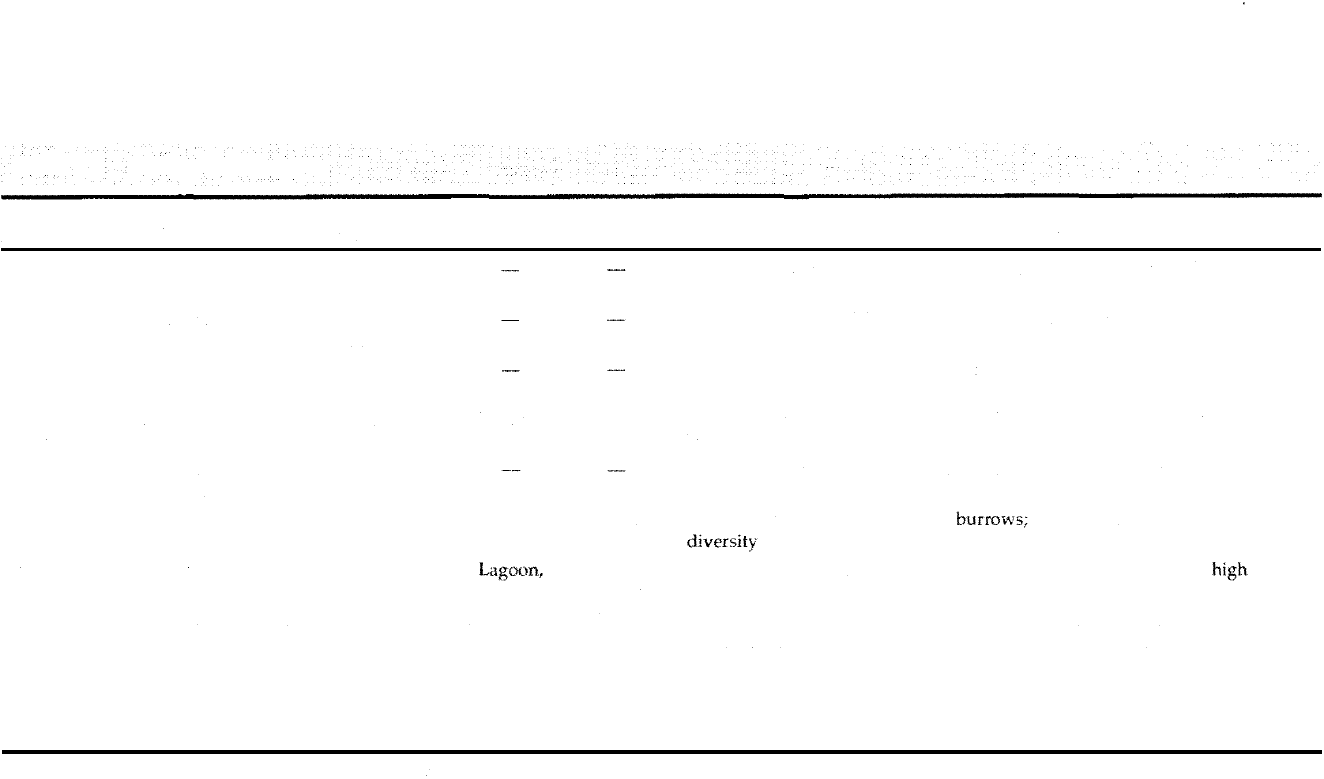
.
g
b 4.3
Pp icfacies
-
Ichnofacies Substrate
Environment
Teredolites
Wood ground
Estuarine, nearshore
marine
Trypa nites
Rockground
Rocky coasts, reefs,
hard-grounds
Scoyenia
Firmground
Freshwater,
terrestrial
Clossi-
Firmground
Marine to nonmarine
fu ngites
Psilonic/m us
Softground
Marine to nonmarine
sand, mud
Skolithos
Softground Marine
sand
Cruziana
Softground
Marine
sand, mud
Zoophycos
Soft ground
Marine
mud
Nereites
Softground Marine
sand, mud
Water
depth
Various
Beach
Water
energy
Various
High
Medium
shelf
to low
Slope-abyssal Low
Slope-
Turbidity
abyssal
crent
event
Distinguishing characteristics
Club-shaped, stumpy to elongate, subcylindrical to subparallel borings
Cylindrical, tear-, or U-shaped, vertical to branching borings
Horizontal to curved or tortuous burrows; sinuous crawling traces; vertical
cylindrical to branching shafts; tracks and trails
Ve rtical, cylindrical, U- or tear-shaped borings and/ or densely branching
burrows
J-, Y-, or U-shaped burrows; vertical shafts and horizontal tunnels; tracks,
t
rails, root traces
Ve rtical, cylindrical, or U-shaped
very few horizontal burrows; low
Mixed association of vertical, inclined, and horizontal structures;
diversity of traces
Simple to moderately complex grazing and feeding structures; horizontal to
slightly inclined feeding or dwelling structures arranged in delicate sheets,
ribbons, lobes, or spirals
Complex horizontal, crawling, and grazing traces and patterned feeding/
dwelling traces; low diversity
Data from: Bromle
y
d al., 1984; Frey and Seilachr, 1980; Frty and P(• mbcrton, 1987; Pemrton ct a!., 12; Se ilacher, 1967.
